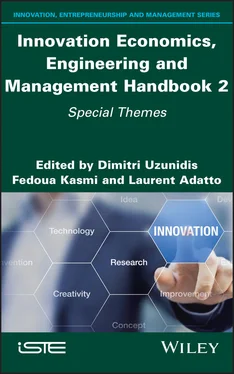The PSI approach is also the way to question the priorities we define. Let us take the water crisis as an illustration. A lack of water is no longer the prerogative of poor countries and now affects rich countries. In this context, is it not anecdotal to plan to create a device that allows the first two liters of water that arrive cold in the shower and are, most of the time, wasted to be recouped, when we know that, in London, losses and leaks caused by a dilapidated distribution network are estimated to be the equivalent of 300 Olympic swimming pools per day, or that 20% of water is wasted before it even reaches homes (Carrington 2017)? Let us also take the example of masks. Their use has become widespread as part of the fight against the COVID-19 pandemic. However, this is not a good thing; because of their single use, they have a negative impact on the environment, whether we consider their footprint from the point of view of the consumption of materials they represent or the pollution they cause, as deplored by activists from the NGO Oceans Asia in Hong Kong. If the disposable mask materializes the choice of a device that prioritizes access to health for all over environmental preservation, other directions are possible, such as Le Mask français (the French Mask), which has a reusable part that reduces waste but which may have a slightly higher cost. We can see through this example how the PSI approach leads to a reflection on the values that we wish to have, a reflection that allows us to innovate consciously. We can finally make the hypothesis that the PSI approach is a vector for asking ourselves about the problems we are dealing with. We join Navi Radjou for whom “brainstorming to solve problems that do not exist is over. We need to go to the field to solve the real problems around energy, health and education” (Radjou 2020). In the same way, the PSI approach seems capable of leading us to question the current trend that tends to establish a hierarchy between social issues, as if the ecological question were more important and deserved priority treatment over the issues of equity, freedom, the aging population or the inclusion of people with disabilities. Finally, the PSI approach is a way to avoid false good ideas, such as the creation of reusable straws. These straws were born of the realization that every day 1 billion non-recyclable straws are thrown away worldwide, including nearly 9 million in France in fast food restaurants alone. But shouldn’t a real sensitivity to environmental issues invite us to stop drinking from straws in order to stop wasting straws rather than creating recyclable straws? Similarly, the management of the plastic waste that invades our soil, our rivers and our oceans is currently viewed through the prism of recycling, presented as the miracle solution. But as Nathalie Gontard points out, “this mirage overshadows the only real solution: reducing plastic production” (2018).
Finally, it should be pointed out that while the PSI approach invites debate on the world we are shaping, this debate is not the prerogative of politicians and scientists, a sort of “republic of experts”, who would be the only ones with the intellectual bases required for debate. Because it takes place during the design process itself, the question of meaning engages the designer and all stakeholders in the design process and cannot be restricted to so-called “responsible” or “social” innovations (Chouteau et al . 2020).
Table 1.1. Putting the PSI and Jonas approaches into perspective (according to Forest 2020)
| PSI approach |
Criteria |
Jonas concept |
| Innovating with awareness |
Basis for action |
Principle of responsibility |
| Political heuristics |
Underlying heuristics |
Heuristics of fear |
| Thinking about the meaning of what we create and, through it, our humanity. |
Function of heuristics |
Ensuring the survival of humanity |
| During the design process |
Questioning time |
Ex post observation: the fact that a technique is potentially dangerous must lead to its suspension because the irreversible nature of the consequences “forbids rolling the dice”. |
| Strength of proposals |
Nature of the prescriptions |
Force of restrictions or even prohibitions |
| Technical democracy (designers, users, institutions, etc.) |
Key player |
An elitism in favor of committees of wise men (a benevolent dictatorship) |
It is clear from the above that the PSI approach implies thinking about innovation beyond the mere question of the potential value for the user by integrating, from the outset, the relationship that the innovation in question has with our society. This approach implies the use of critical thinking, i.e. it invites us to develop a state of mind and practices that allow us to emancipate ourselves from the register of the promises of innovation in the making and to think about the meaning of each projected direction 20. It is on this condition that it is possible for us to question ourselves collectively about the choices we make and the directions we favor and thus to innovate consciously. We know, for example, that the construction of a tramway line leads to higher land prices, which can result in socio-spatial segregation. In the Sustainable City Factory project, the PSI approach thus rehabilitates the eminently political question of what we decide to do (building eco-neighborhoods or reducing socio-spatial segregation?) and the place of the human and social sciences in thinking about tomorrow’s innovation.
1.6. By way of conclusion
Today, our society is faced with unprecedented challenges (access to water, education, health, waste and pollution management, etc.) in a context marked by ecological urgency. However, if the situation seems desperate, it is not necessary to despair of everything.
In the above, and after having indicated that the questioning of innovation is in fact not a criticism of innovation but a criticism of its loss of meaning, we have presented the PSI approach, which places the question of the political meaning of innovation in the very process of innovation.
The latter supposes that we extend our thinking beyond the point where it takes us today, i.e. beyond the sense of innovation for the user. To mobilize the PSI approach is indeed:
– to use a reflexive approach that involves our critical faculties and helps the designer to work within common sense, i.e. in a sense that is accepted by and acceptable to all because it meets the values of our society, values that should not be forgotten and are culturally and historically located;
– to work against the dictatorship of “ever more” because our society does not always demand more innovation; it wants the best.
Some will no doubt see in the PSI approach a heroic conception of the designer. This is a conception that we willingly accept on the condition that we appreciate this heroism not in the designer’s capacity to transform the world but in their capacity to become philosophers in action and to reintroduce a certain form of wisdom.
Brown, T. (2008). Design thinking. Harvard Business Review , 84–92.
Brundtland, G.H. (1987). Notre avenir à tous. Rapport de la commission mondiale pour l’environnement et le développement, Fleuve, Montreal.
Carrington, D. (2017). Water companies losing vast amounts through leakage. As drought fears rise. The Guardian , 11 May 2017 [Online]. Available at: https://www.theguardian.com/environment/2017/may/11/water-companies-losing-vast-amounts-through-leakage-raising-drought-fears.
Читать дальше












